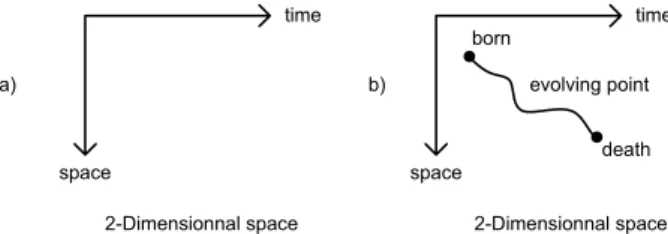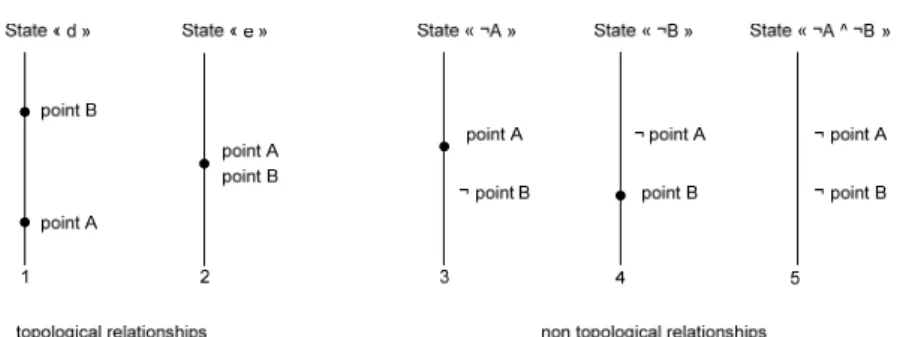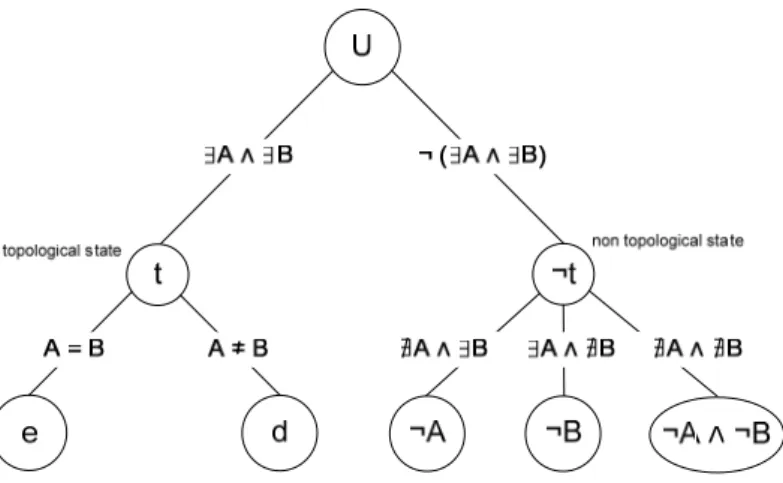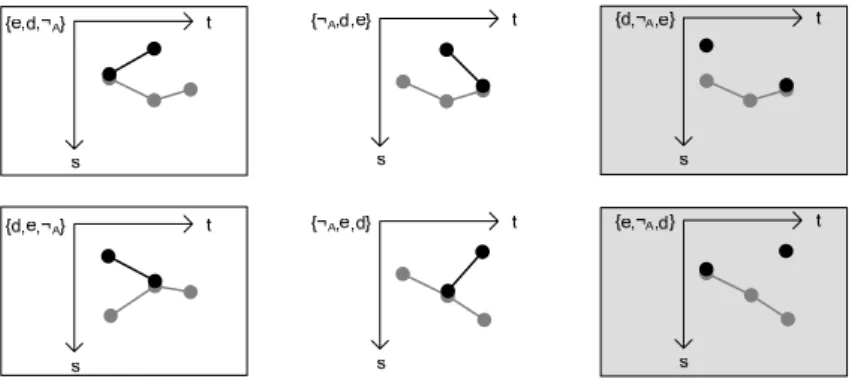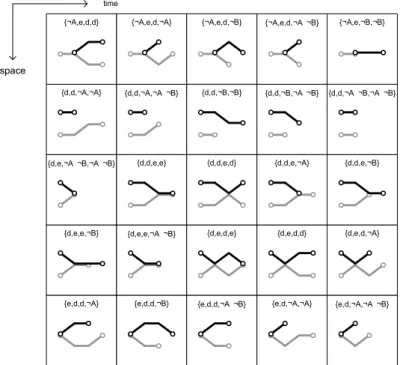Spatio-temporal configurations of dynamics points
in a 1D space
Pierre Hallot1, Roland Billen1
1 Geomatics Unit, University of Liège, Allée du 6 Août, 17 B-4000 Liège Belgium
{P.Hallot@ulg.ac.be, rbillen@ulg.ac.be}
Abstract. This paper describes a spatio-temporal configurations building
approach, which has been applied to dynamics points in 1-dimensional space. In this approach, a temporal logic, Allen’s time intervals, is crossed with a new spatial logic based on topology called spatial states. These spatial states are derived from topological relationships and a new concept of degenerate topological relationships. This work is the first step of a PhD research aiming to create a generalized spatio-temporal reasoning model based on topological relationships between spatio-temporal histories .
Keywords: Spatio-temporal modelling, spatio-temporal relationships, lifelines,
spatio-temporal configuration, spatial states, degenerate topological relationships.
1 Introduction
For years now, several research communities (GIS, AI, etc.) have investigated spatio-temporal representations and reasoning. It was a logical evolution after putting so much effort in (qualitative) spatial reasoning and temporal reasoning. Indeed, there is a lot of applications where spatio-temporal reasoning is or could be beneficial: movement description, monitoring objects, region evolution, trajectory calculus, epistemology, crime mapping, on board-GPS analyses, etc. In behavior and monitoring interpretation for instance, spatio-temporal reasoning could be used to reason about the interaction of people with their environment or to describe motion patterns of moving objects (peoples, animals, vehicles…) [1-7].
So far, different types of spatio-temporal reasoning models have been developed. Some of them combine spatial and temporal logic; they “temporalize” spatial reasoning models. Others try to create spatio-temporal mereotopology directly from the spatio-temporal histories of life-lines [8]. Following this latter approach, we aim to develop a generalised spatio-temporal calculus based on spatio-temporal histories. The underlying idea is to extract spatio-temporal information by applying topological calculi on life-lines (e.g. considering a life-line as a line in 2D geometrical space). As a preliminary mandatory study, we wish to build the entire set of a specific kind of spatio-temporal configurations mixing topological and temporal information. For this purpose, we use Allen’s time interval and a new spatial logic based on topology called
spatial states. We have decided to start with spatio-temporal configurations between two moving points in a 1D space. This will be extended to 2D and 3D spaces and later, extended to other spatial objects (lines, regions and bodies). Further the establishment of such exhaustive configurations, our aim is to obtain in the future a framework allowing evaluating the relevance of spatio-temporal models. In other words, checking if a given model allows or not to retrieve all the possible spatio-temporal configurations.
The paper is structured as follow. First we make a brief description of models and concepts used thereafter. Then, we expose our general research objectives. After, we develop the approach used to build the spatio-temporal configurations and finally, we conclude.
2 Spatial, temporal and spatio-temporal reasoning
2.1 Spatial Reasoning
Most common spatial reasoning models are based on topology. We wish to cite in this section the 9-i model [9] and the RCC model [10, 11]. The former one is based on the study of intersections between spatial objects topological primitives (see figure 1). The latter is based on the Clarke’s connectivity relationship. Both of them gave equivalent sets of topological relationships for regions.
Fig. 1. Topological relationships between two regions in conceptual neighbourhood diagram
[12].
2.2 Temporal Reasoning
Allen’s time interval reasoning is the most well-known reasoning model used in time modelling. His theory of action and time proposes a formalism based on a temporal logic which is used to represent and reason about events, action, beliefs, intentions, causality, and serve as a framework for solving problems [13]. The time primitive
used by Allen is the interval. On this basis, he introduced a set of thirteen mutually exclusive binary relations between intervals (figure 2). The time is assumed to be linear, dense and consequently infinite in the past and future.
Fig. 2. Thirteen interval relationships defined by Allen (from [14]).
2.3 Spatio-temporal Reasoning
A logical evolution after putting so much effort in spatial and temporal reasoning was to combine them to obtain spatio-temporal reasoning models [15,16]. Spatio-temporal representing and reasoning can be envisaged in two different ways [8]. First one is the combination of a spatial logic with a temporal logic. Some spatial snapshots are combined in a temporal reasoning to derivate spatio-temporal information. The second one is to view the world as spatio-temporal histories and create new reasoning based on spatio-temporal entities [17].
Some of the most achieved realizations illustrate this duality. First, Wolter and Zakharyaschev propose in [15] to combine the constraints formalism RCC-8 with the Propositional Temporal Logic (PLT) [13]. Gerevini and Nebel combine the RCC-8 with Allen’s Interval Calculus that is closer in spirit from RCC-8 than PLT, focusing on the computational complexity of such approach.
Combining both approaches, Claramunt and Jiang cross topological relationships and Allen’s time intervals in [1, 18, 19] to deduce spatio-temporal histories of static objects (segments and regions). They have defined a temporal region as a region of space valid for a convex temporal interval (see figure 3). This idea can be used for regions but also for points.
Fig. 3. Visual presentation of relationships in a 2-dimensional space (from [1]).
Finally, Muller considers space-time histories of objects as primitive entities to analyse directly spatio-temporal shapes or histories. He defines a specific space-time to characterise classes of spatial changes [20], which is the first full mereotopological theory based on space-time as a primitive. More recently the works of Hazarika concern a better understanding of spatio-temporal histories continuity [8]. It is worth mentioning a new model, the QTC [6, 21] dealing with direction, speed and acceleration information between moving points.
3 General research objectives
Our research is inspired originally by Claramunt’s and Muller’s works and considers spatio-temporal space as a primitive space. Our main research objective is to use topology to express relationships between spatio-temporal histories of moving objects. Indeed, by considering a primitive space (spatial and temporal dimensions are not differentiates) [17], we end up considering two lines (the life-lines) and their topological relationships (see [22] for preliminary research objectives). In other words, lifelines are just considered as normal lines in a 2D space. It is therefore possible to analyse topological relationships between them (topological relationships between lines in a 2D space). We aim to end up with a generalized spatio-temporal calculus based on a set of topological relationships between spatio-temporal histories, which should beneficiated of existing topological calculi
Fig. 4. Examples of spatio-temporal information extraction based on topological relationships
between life-lines. This space-time representation is explained in section 4.
Figure 4 illustrates the type of information we wish to extract from such model. In figure 4 a, the “intersect” topological relationship between the two lifelines indicates without ambiguity that there is collision between the two points (spatial and temporal meeting between the two objects), when in figure 4 b., the “disjoint” topological relationship indicates no collision. Note that studying the projections of life-lines on the temporal and spatial axis does not allow differentiating the two behaviors and therefore does not provide enough information to detect a collision.
Beyond these examples, we believe that others topological relationships might have spatio-temporal meaning and could of some use for others analyses as crime mapping or epistemology. We think also that one of the major interests of this approach could be the generalization of all the possible configurations into a smaller set of topological relationships (33 in the lines case [9]). Assuming that enough spatio-temporal meaning would be associated to these relationships, we could use existing topological models and calculi and hopefully increase speed analysis and understanding of spatio-temporal configurations.
The aim of the present paper is to build the entire set of spatio-temporal configurations between two points in a one dimensional space. Beyond the interest of getting these configurations per se, this will help us to study the relevance of different spatio-temporal models to retrieve spatio-temporal configurations. This will also be useful when studying generalisation processes.
The next sections describe our spatio-temporal configurations building approach.
4 Building of a set of spatio-temporal configurations
This section presents an approach allowing extracting spatio-temporal configurations between two dynamic points from topological and temporal information. Considering degenerate notions of topological relationships between two points (see section 4.1) and the well-known Allen time intervals, we derive all the possible (in respect to these concepts at least) spatio-temporal configurations between two dynamic points. At this
stage of our research, we have decided to start with a simple case; dynamic points in a 1D space. Points are the simplest spatial objects (0D) and they could not move in a space lower than 1D. We assume that points can not go back in the past, i.e. the temporal dimension is oriented (in accordance with Allen’s theory).
Practically, with one spatial and one temporal dimension, we can plot a 2-dimensional space with one dimension attributed to each axis. This space is called a temporal space in accordance to Claramunt [18].
time space time space evolving point a) b)
2-Dimensionnal space 2-Dimensionnal space death born
Fig. 5. 2-dimensionnal temporal space with the evolution of a 1-dimensional object.
The existence of a point in this space will be represented by a line-segment. The beginning and the end of the line-segment correspond respectively to the “born” and the “death” of the point-life. This representation is called spatio-temporal history or life-line in the dynamic’s point case. Both terms will be used in this paper. All the future representations will be plotted with the same convention and orientation axis as in figure 5 Note that we do not want to impose continuity of spatio-temporal histories. This assumption could be added for specific applications if needed.
4.1 Topological relationships and degenerate topological relationships
The spatial relationships considered here are topological relationships. First, we know that they are two possible topological relationships between two points; disjoint or equal (figure 6, cases 1 and 2).
Fig. 6. Representation of the 5 different topological and degenerate topological states between
points.
To fully encompass spatio-temporal information complexity, we wish to propose degenerate cases of topological relationships between points. The underlying idea is that at certain moments in time, when considering the life-line of two points A and B, point A or point B might not exist. In such cases, binary topological relationships are no longer valid. Therefore, we propose to consider three other “states” in addition to the two topological “states” (disjoint and equal) which cover all the cases of existence or non existence of points. In this context, a “state” is a particular relationship between objects at a given time. This concept is therefore time independent. The cases 3 to 5 from figure 6 illustrate the three “non-topological” states: “¬B” when point B does not exist, “¬A” when point A does not exist and “¬A ⋀ ¬B” when none of them exist.
The set of states “d”, “e”, “¬A”, “¬B”, “¬A ⋀ ¬B” is a Jointly Exhaustive and Pairwise Disjoint (JEPD) set of topological and degenerate topological relationships. In the decision tree (figure 7), one can find also the state “t” which means that the two points exist and have a topological relationship and the state “¬t” gathering the non topological states. We believe that such concepts correspond to a lot of real cases, just mention the analysis of moving GPS antennas with some cycle slips.
Fig. 7. Decision tree representing the JEPD set of spatial states.
A spatio-temporal configuration can be seen as a succession of different states in time. The study of spatio-temporal histories successive states transitions is out of the scope of this paper. In the following, when representing the life-line of a dynamic point A, we will join successive states where the point A exists.
4.2 Combination of states: the tuple
The method we used to obtain the entire spatio-temporal configuration set is based on the mapping of spatial information (different states) and a temporal logic (Allen’s time interval in this case). To be able to combine them, we compose states in a structure called the “tuple”. A tuple is defined as a combination of n states, where n is an integer and represents the level of the tuple. Let ε be the set of possible states values: “e”, “d”, “¬A”, “¬B” and “¬A ⋀ ¬B”, a tuple of level n is denoted as tn
{ε1, …, εn} with ε1, …, εn ∈ ε . The major interest of this combination is that there is no order between the different states (ε1, …, εn). Indeed, if ordered the combination of different states may include temporal information, e.g. the succession of the three states “e”, “d” and “¬A” in time lead to a temporal relationship “starts” only (figure 8). The order of the states in tuple is obtained by crossing it with temporal relationships.
Fig. 8. Succession of states {e,d, ¬A} inducting temporal relationships.
Note that the states “¬t” and “t” could be used to provide a greater level of generalization.
4.3 Spatio-temporal configuration: mapping of tuples with time
Crossing spatial states tuple axis S with Allen’s intervals axis T, we can map a spatio-temporal space containing spatio-spatio-temporal configurations. Figure 9 shows an example of creation. Let’s consider the tuple t3{e,d,¬A} combined with temporal relationships “starts”. Theoretically, it corresponds to 6 possible arrangements of spatial states: {e,d, ¬A}, {d,e, ¬A}, {¬A,e,d}, {¬A,d,e}, {e,¬A,d}, {d,¬A,e}. By combining these states with Allen’s time intervals, we need to impose continuous life-line, the last 2 cases {e, ¬A, d}, {d, ¬A, e} must be withdrawn. In this particular case, the combination of the tuple t3{e,d,¬A} with the temporal relationships “start” lead us to select the two cases where the ¬A state is at the end of the state’s succession (squared in white on figure 9).
Fig. 9. Possible combination of the 3-tuple t3{e,d, ¬A}, the spatio-temporal configuration
squared in white are the only two valid when crossing the tuple with temporal relationships “starts”.
In a similar way, we have derived all the spatio-temporal configurations (279 for level 4) for dynamic points in 1D with Allen’s intervals continuity assumption. It appears that it was necessary to consider level 4 tuples and combining them with the entire set of temporal relationships. A level less than 4 cannot be combined with temporal relationships as “overlaps” or “overlapped”. Working with upper levels than 4 seems to be just a combination of smaller levels, however for future analyses we believe that considering level 6 tuple would be necessary. Figure 10 presents an extract of spatial configurations derived from level 4 tuple.
space
{e,d,d,¬A} {e,d,d,¬B} {e,d,d,¬A ¬B} {e,d,¬A,¬A} {e,d,¬A,¬A ¬B} {d,e,e,¬B} {d,e,e,¬A ¬B} {d,e,d,e} {d,e,d,d} {d,e,d,¬A} {d,e,¬A ¬B,¬A ¬B} {d,d,e,e} {d,d,e,d} {d,d,e,¬A} {d,d,e,¬B}
{d,d,¬A,¬A} {d,d,¬A,¬A ¬B} {d,d,¬B,¬B} {d,d,¬B,¬A ¬B} {d,d,¬A ¬B,¬A ¬B} {¬A,e,d,d} {¬A,e,d,¬A} {¬A,e,d,¬B} {¬A,e,d,¬A ¬B} {¬A,e,¬B,¬B}
time
Fig. 10. Extract of spatio-temporal configuration generated from tuple t4 with continuity assumption.
The non continuous histories can be derived from the continuous histories configurations. Figure 11 represents an extract of the possible non continuous histories; the all set of (625) being accessible at the following address: http://www.geo.ulg.ac.be/hallot/.
Fig. 11. Extract of spatio-temporal configuration generated from tuple t4 without continuity assumption.
5 Conclusions
Spatio-temporal reasoning models aim to describe the real world dynamic phenomena’s. They can be of two kinds: either they mix spatial or temporal reasoning model or they describe directly new spatio-temporal mereotopology [8]. In this paper, we have developed an innovative approach using known spatial (topology) and temporal (Allen’s time intervals) logics to build a specific set of possible spatio-temporal configurations. Building this set of spatio-spatio-temporal configurations is the first step of a global research aiming to develop a generalized spatio-temporal reasoning model. Such model, briefly sketched in this paper, aims to extract spatio-temporal information from life-lines by considering primitive space topological calculi. We wish to end up with a set of topological relationships containing enough spatio-temporal meaning to perform relevant spatio-spatio-temporal analyses. Getting these configurations is a necessary step to study the relevance of such kind of spatio-temporal model.
We start from the definition of degenerate topological relationships between two points allowing relationships between non coexistent points. Combined with topological relationships, we obtain a JEPD set of spatial states which are particular relationships between objects at a given time. Spatio-temporal histories can be seen as a succession of states. After, we define a time free combination of states called “tuple”. This new representation of two moving points spatiality is crossed with a temporal logic (Allen’s time intervals) to create the entire set of spatio-temporal configurations (279 for level 4).
In the future we wish to extend the spatio-temporal configurations to higher dimensions and to other types of spatial objects. Then, we plan to develop further the generalized model and testing its relevance using real data (GPS).
Finally, we believe that our approach could be also complementary to existing qualitative spatial reasoning models. For instance, the Qualitative Trajectory Calculus [6, 21, 25] is based on analysis of direction, speed and acceleration between two dynamic points. Such calculus can only be used when the two points are coexisting. Our approach could be a nice preliminary analysis to select only the cases where QTC can be used.
6 Bibliography
1. Claramunt, C., Jiang, B.: An integrated representation of spatial and temporal relationships between evolving regions. Journal of Geographical Systems 3 (2001) 411-428
2. Claramunt, C., Jiang, B., Bargiela, A.: A new framework for the visualisation of urban traffic data. Transportation Research Part C 8 (2000) 167-184
3. Erwig, M., Schneider, M.: A visual language for the evolution of spatial relationships and its translation into a spatio-temporal calculus. Journal of Visual Languages and Computing 14 (2003) 181-211
4. Sinha, G., Mark, D.M.: Measuring similarity between geospatial lifelines in studies of environmental health. Journal of Geographical Systems 7 (2005) 115-136
5. Thériault, M., Claramunt, C., Villeneuve, P.Y.: A Spatio-temporal taxonomy for the Representation of Spatial Set Behaviours. In: Bèohlen, M.H., Jensen, C.S., Scholl, M.O. (eds.): Spatio-temporal database management : International Workshop STDBM'99. Springer, Edinburgh, Scotland (1999) 18
6. Van de Weghe, N., Cohn, A.G., De Tre, G., De Maeyer, P.: A Qualitative Trajectory Calculus as a Basis for Representing Moving Objects in Geographical Information Systems. Control and Cybernetics 35 (2006)
7. Laube, P., Kreveld, M., Imfeld, S.: Finding REMO — Detecting Relative Motion Patterns in Geospatial Lifelines. Developments in Spatial Data Handling (2005) 201-215
8. Hazarika, S.M.: Qualitative Spatial Change: Space-time Histories and Continuity. School of Computing, Vol. PhD. University of Leeds, Leeds (2005) 250
9. Egenhofer, M., Herring, J.: Categorizing Binary Topological Relations Between Regions, Lines and Points in Geographic Databases. Technical Report. Department of Surveying Engineering, University of Maine (1990) 28
10. Cohn, A.G.: Calculi for Qualitative Spatial Reasoning. In: Clamet, J., Campell, J., Pfalzgraf, J. (eds.): Artificial Intelligence and Symbolic Mathematical Computation. Springer-Verlag, Berlin (1996) 124-143
11. Cohn, A.G., Bennett, B., Gooday, J.M., Gotts, N.M.: Qualitative Spatial Representation and Reasoning with the Region Connection Calculus. Geoinformatica 1 (1997) 275-316
12. Freksa, C.: Conceptual Neighborhood and its role in temporal and spatial reasoning. In: Singh, M., Travé-Massuyès, L. (eds.): Proceedings of the IMACS Workshop on Decision Support System and Qualitative Reasoning, Amsterdam, Holland (1991) 181-187
13. Pani, A.K., Bhattacharjee, G.P.: Temporal representation and reasoning in artificial
intelligence: A review. Mathematical and Computer Modelling 34 (2001) 50-80
14. Allen, J.F.: Time and time again: the many ways to represent time. International Journal of Intelligent Systems 6 (1991) 341-355
15. Wolter, F., Zakharyaschev, M.: Spatio-temporal representation and reasoning based on
RCC-8. Seventh Conference on Principles of Knowledge Representation and Reasoning, KR2000. Morgan Kafmann, Breckenridge, USA (2000) 3-14
16. Gerevini, A., Nebel, B.: Qualitative Spatio-Temporal Reasoning with RCC-8 and Allen's Interval Calculus: Computational Complexity. ECAI 2002. IOS Press (2002) 312-316 17. Muller, P.: Éléments d'une théorie du mouvement pour la formalisation du raisonnement
spatio-temporel de sens commun. Institut de recherche en informatique de Toulouse. Université Paul Sabatier, Toulouse (1998) 219
18. Claramunt, C., Jiang, B.: A representation of relationships in temporal spaces. In: Atkinson, P., Martin, D. (eds.): Innovations in GIS VII: GeoComputation, Vol. 7. Taylor & Francis, London (2000) 41-53
19. Claramunt, C., Thériault, M., Parent, C.: A qualitative representation of evolving spatial entities in Two-dimensional Topological Spaces. In: Carver, S. (ed.): Innvation in GIS V, Vol. 5. Taylor & Francis, London (1998) 119-129
20. Muller, P.: Topological Spatio-Temporal Reasoning and Representation. Computational
Intelligence 18 (2002) 420-450
21. Van de Weghe, N.: Representing and Reasoning about Moving Objects: A Qualitative
Approach (Volume I). Department of Geography - Faculty of Sciences. Ghent University, Ghent (2004) 168
22. Hallot, P.: Spatio-temporal relationships in a primitive space: an attempt to simplify spatio-temporal analysis. In: Raubal, M., Miller, H.J., Frank, A., Goodchild, M. (eds.): Fourth International Conference Geographic Information Science, GIScience 2006, Vol. 28. IfGI prints, Münster (2006) 277-283
23. Allen, J.F.: Towards a general theory of action and time. Artificial Intelligence 23 (1984) 123-154
24. Allen, J.F.: Maintaining Knowledge about Temporal Intervals. Communications of the
ACM - The University of Rochester 26 (1983) 832-843
25. Van de Weghe, N., Cohn, A.G., Bogaert, P., De Maeyer, P.: Representation of moving objects along road network. 12th International Conference on Geoinformatics - Geospatial Information Research: Bridging the Pacific and Atlantic, University of Gäve, Sweden (2004) 187-194
![Fig. 1. Topological relationships between two regions in conceptual neighbourhood diagram [12]](https://thumb-eu.123doks.com/thumbv2/123doknet/6133231.156594/2.892.241.651.669.830/fig-topological-relationships-regions-conceptual-neighbourhood-diagram.webp)
![Fig. 2. Thirteen interval relationships defined by Allen (from [14]).](https://thumb-eu.123doks.com/thumbv2/123doknet/6133231.156594/3.892.316.569.278.550/fig-thirteen-interval-relationships-defined-allen.webp)
![Fig. 3. Visual presentation of relationships in a 2-dimensional space (from [1]).](https://thumb-eu.123doks.com/thumbv2/123doknet/6133231.156594/4.892.216.675.217.530/fig-visual-presentation-relationships-dimensional-space.webp)

